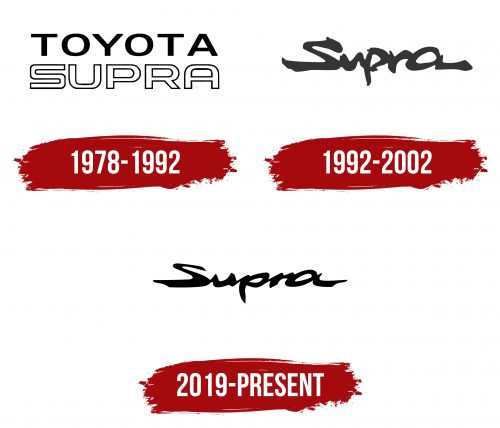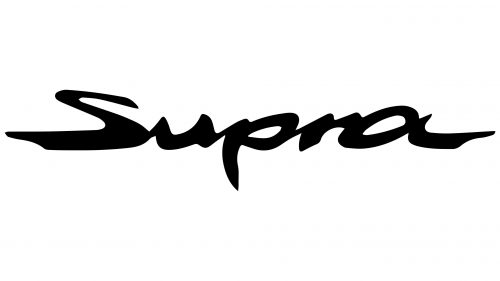The Toyota Supra logo combines emotion and complexity. It serves as a visual tuning fork, ensuring the perfect technical condition of the vehicles. The emblem conveys the superiority of the cars, high performance, and peak enjoyment of driving this brand’s cars.
Toyota Supra: Brand overview
When Toyota debuted the Celica Supra in 1978, the Toyota Supra’s history officially began. The vehicle started as a more opulent and potent version of the Celica but eventually developed into a stand-alone model.
Production of the A40/A50 Celica Supra, the first generation model, lasted from 1978 until 1981. This vehicle had a 110-horsepower 2.6-liter inline-six engine. It differed from the standard Celica with an expanded wheelbase and more sophisticated equipment.
The second generation (A60) was released in 1981 and manufactured through 1985. This variant received a more potent 2.8-liter engine and an independent rear suspension. The design became increasingly geometric, emulating the styles of the 1980s. Regarding placement and design, the car started to deviate from the Celica in this generation.
Produced between 1986 and 1993, the third generation (A70) was the first to detach from the Celica fully. It had a brand-new 3.0-liter inline-six engine called the 7M-GE, which the 7M-GTE, a turbocharged variant, later followed. Improved aerodynamics and a more athletic demeanor defined this generation.
Introduced in 1993, the fourth generation (A80) became the most well-known and iconic. Production continued until 2002. This vehicle had a ground-breaking design and the venerable 3.0-liter inline-six twin-turbo 2JZ-GTE engine, which could produce up to 320 horsepower in factory configuration. Due to its great capacity for customization, the A80 model rose to become one of the quickest Japanese cars of its era and had enormous popularity among tuners.
The manufacture of cars stopped after 2002 due to stricter environmental restrictions and shifting market trends.
Fans anxiously anticipated the renowned model’s comeback during the ensuing 17 years. Toyota periodically displayed different concept cars to allude to a potential return.
Following years of waiting, Toyota unveiled the fifth generation (A90) in 2019. Many parts of the new vehicle are similar to those of the BMW Z4, created in partnership with BMW. Its 3.0-liter inline-six turbocharged engine generates 335 horsepower; a 2.0-liter variant is also offered in certain areas.
Fans’ reactions to the car’s resuscitation were not unanimous. Some felt the car’s “Japanese essence” was compromised because of the strong relationship with BMW. Others expressed their happiness at the well-known brand’s comeback and gave the new generation’s energetic performance great marks.
As part of its ongoing development, Toyota added a manual gearbox and increased the 3.0-liter engine’s power to 382 horsepower in 2020 and 2021, which many enthusiasts felt was necessary for a “true” Supra.
Every model represented both Toyota’s approach to building sports vehicles and the technological innovations of the day.
Meaning and History
What is Supra?
It is a Japanese vintage sports car known for its iconic position in the automotive industry, powerful performance, and stylish styling from Toyota. The car was first introduced as an improved version of the Toyota Celica but has since become a separate production line, providing the perfect balance of handling, style, and power. Its powerful inline six-cylinder engines and front-engine rear-wheel drive layout quickly made it a serious contender in the sports car industry. In addition to its stunning performance, the car had a major impact on pop culture. It has been featured in many anime shows, video games, and movies, which has helped it establish itself as a true automotive icon.
1978 – 1992
The Toyota Supra emblem helps instantly identify the brand, capturing the essence of its unique car lineup. It reflects driving precision, swiftness, and the emotions enthusiasts experience. Every detail is meticulously planned to maintain perfect symmetry.
The logo prominently displays the name of the lineup without any extraneous elements. The text is arranged in two rows, first emphasizing the well-known manufacturer’s name and then introducing the new model. The phrase “Toyota Supra” is written in different fonts:
- Bold black on top
- Outline white on the bottom
In both cases, the letters are sans-serif, indicating the company’s commitment to meeting customers’ preferences and needs. The lack of serifs also symbolizes the absence of obstacles for this brand’s cars: excellent handling, high maneuverability, and guaranteed safety.
The second line features many rounded letters with smooth curves and gentle turns. There are no angles or sharp strokes – everything is smooth, balanced, and well-designed. Additionally, the glyphs resemble the sharp curves of the Nürburgring track, where the cars undergo testing. This logo goes beyond simple aesthetics, conveying the experience, challenge, performance, and expertise of the engineers behind the high-speed car lineup.
The uppercase font creates a sense of perfection and smoothness in the cars’ performance. Each letter embodies the company’s unwavering commitment to providing everything needed for the vehicles, from internal components to exterior design. They reflect the key characteristic of fast sports cars: reliability. The logo indicates these sports vehicles’ strength, stability, and power.
1992 – 2002
The emblem has been reduced to a single, most important word, serving several functions:
- Acts as a Latin prefix meaning “above” or “beyond,” indicating something of superior quality.
- Briefly outline this car model line’s technical characteristics and capabilities (better than others).
- Represents the name of the lineup belonging to the well-known automobile corporation Toyota.
The text is set in a lowercase, cursive-like font, mimicking a quick handwritten style. However, it lacks the slant typical of hurried handwriting. Instead, the letters are upright, without any hint of italics. This signifies the company’s stability, adherence to established norms, and desire to control every situation without succumbing to momentary emotional surges.
At the same time, the glyphs are squashed from the top and bottom, as if under immense pressure – a sensation akin to driving at high speed. This unusual typography gives the impression that the letters are deformed, appearing as if hastily painted on a wall.
Among the notable features of the emblem is the disproportion of the symbols. In some cases, this is intentional, while in others, it is not. For example, the capital “S” resembles a winding road, the lowercase “p” looks like a turning point for a car, and the “a” appears as a circular section.
Thus, the Toyota Supra logo transcends simple aesthetics, conveying much more than it seems at first glance. It is a visual allegory of peak emotions and intense sensations, representing moments of extreme stress for both people and machines. Yet, the glyphs flow smoothly into one another, maintaining consistent line thickness. This implies a cohesive design, symbolizing the harmonious unity of the vehicle and the driver, a key quality of all sports cars.
2019 – today
The logo was designed by Toyota’s in-house design team, aiming to create a unique and memorable image that reflects the car’s dynamic and powerful nature. The designers drew inspiration from motorsports and sought to create an emblem visually conveying speed and elegance. Inspiration for the design was drawn from testing experiences on the Nürburgring race track, where the Toyota Supra showcased its superior performance.
The Supra logo features the model name rendered in cursive, imitating a casual handwritten script. The letters are flattened, interconnected, and tilted in various directions. Special attention is drawn to the letter “S,” which is disproportionately large and reminiscent of a road stretching into the distance.
The Supra emblem symbolizes dynamism and speed. The tilted and flattened letters convey a sense of motion and velocity, perfectly reflecting the character of a sports car. The prominent “S” at the beginning of the logo represents the S-shaped curve at the Wehrseifen section of the Nürburgring race track, which is known for its challenging terrain and importance in vehicle testing.
The model name “Supra,” derived from Latin, means “above” or “beyond,” highlighting Toyota’s aim to create cars that exceed expectations and set new standards. The logo embodies superior quality, performance, and excellence, aligning with the brand’s philosophy.
The font is rendered in a cursive style, reminiscent of casual handwriting. Each letter flows smoothly into the next, creating a sense of unity and continuity. The slanted letters and asymmetry emphasize dynamism and the sensation of speed.
The emblem is black, symbolizing power, elegance, and professionalism. Black is also associated with luxury and high status, fitting the image of the Toyota Supra as a premium sports car.







